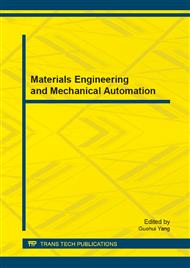p.129
p.134
p.138
p.142
p.147
p.152
p.156
p.162
p.169
Effect of Antibiotic Additions on the Mechanical Properties of Bone Cement
Abstract:
Clinical studies have proved that artificial joints may fail under prolonged gait load, which failure mechanism includes mechanical loosening and infectious loosening. Infectious loosening can be prevented by avoiding osteomyelitis, caused by bacterial infection arising from the marrow cavity, which affects the fixation function of the bone handle. As a result, use of bone cement containing various antibiotics has become an important method for prevention and treatment of infection after artificial joint replacement. This study was aimed to investigate the mechanical properties of bone cement after the addition of antibiotics through the mechanical tests. With the measurements we can then assessed the variations of mechanical strength with the dosage of antibiotics. The results showed that the dose of antibiotics directly affected the compression strength and elastic modulus of antibiotic bone cement. When the antibiotics was added more than 4.8 wt %, the cement strength was obviously affected and reduced, by 27%, indicating that during artificial hip joint replacement, the dose of antibiotics should be concerned, in order to avoid affecting the strength of bone cement and stability of the entire implant.
Info:
Periodical:
Pages:
147-151
Citation:
Online since:
October 2013
Authors:
Keywords:
Price:
Сopyright:
© 2014 Trans Tech Publications Ltd. All Rights Reserved
Share:
Citation:


